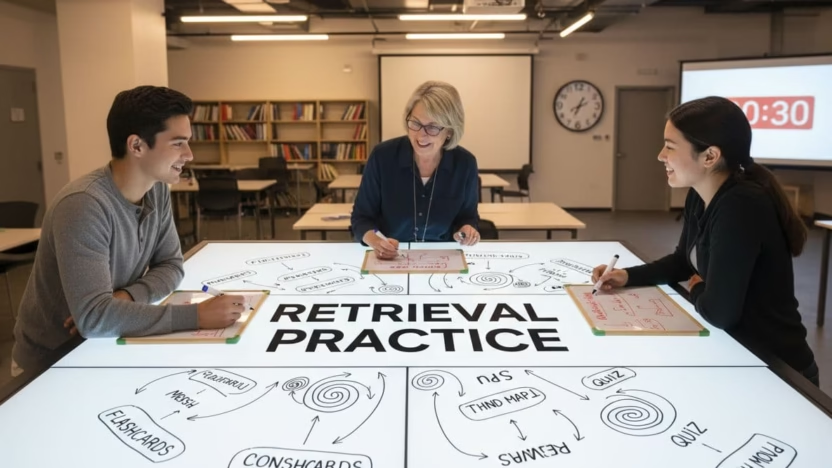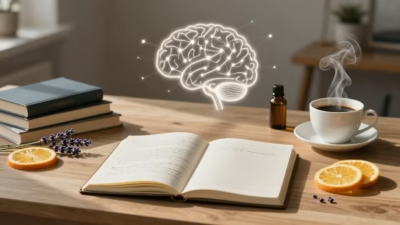Whiteboards can speed up study and make facts stick in minutes. Retrieval practice means trying to recall information from memory without looking at your notes. A fast loop is simple, write your answer, reveal the solution, get feedback, then repeat.
Why do whiteboards help? Quick erase lowers pressure, big writing and standing boost focus, and fast feedback keeps you moving. This works for GCSE and A-level students, uni students, and teachers. Use it for solo study, in pairs, or with a whole class. Expect short, clear steps, science-backed methods, and practical examples for maths, science, languages, and essays.
Key Takeaways
- Retrieval practice beats rereading because it makes your brain work harder to remember, which strengthens memory.
- Whiteboards create fast loops, write your answer, reveal, get feedback, erase, and go again.
- Aim for 30 to 90 second rounds, then short breaks. Repeat hard items later with spacing for better recall.
- Use simple prompts. Mix problem types to avoid illusions of mastery.
- Keep feedback short and specific. Mark right or wrong, then explain one key fix.
- Track hit rate and common errors so your next session targets what matters.
Table of Contents
- Key Takeaways
- Why whiteboards make retrieval practice faster and more effective
- Step-by-step: run fast whiteboard retrieval loops in 20 minutes
- Variations and classroom uses to boost engagement
- Frequently Asked Questions About Retrieval Practice with Whiteboards
- Conclusion
Why whiteboards make retrieval practice faster and more effective
Active recall beats rereading: the testing effect in simple terms
Trying to remember without notes builds stronger memory than reading notes again. Think of the steps of mitosis. If you write them from memory, you strengthen those links more than if you re-read the list. Same for a French verb, write the conjugations first, check second.
For more on building recall, see these active recall techniques for better retention.
Why whiteboards work: quick erase, low fear, and fast feedback
 Dry-wipe boards erase in a second, so you take more shots. That lowers perfectionism and stops you from polishing the same sentence. Big writing and standing up raise energy and focus, which means more items finished per minute. Quick peer or teacher feedback tells you one fix, then you move again. Less friction, more practice, stronger memory.
Dry-wipe boards erase in a second, so you take more shots. That lowers perfectionism and stops you from polishing the same sentence. Big writing and standing up raise energy and focus, which means more items finished per minute. Quick peer or teacher feedback tells you one fix, then you move again. Less friction, more practice, stronger memory.
What is a fast loop? Write, reveal, feedback, repeat
Think of a 60 second cycle. Read the prompt, write what you know, reveal the answer, get one piece of feedback, erase, and move on. Speed and immediate feedback together make recall stick.
Make it stick with spacing and interleaving
Revisit hard items later in the session, then again tomorrow, then in a few days. Mix question types, for example algebra, geometry, and word problems in the same round, so your brain has to spot the method. Keep prompts simple and varied.
Step-by-step: run fast whiteboard retrieval loops in 20 minutes
 This plan works for students and teachers. You can start today.
This plan works for students and teachers. You can start today.
Set up in 2 minutes: tools and layout
- Mini whiteboard, low odour marker, and a small cloth
- Timer on your phone or a simple kitchen timer
- A short question bank or topic list
- Stand if you can, it helps you write fast and stay alert
- For class, seat pairs with room to show boards up front
Keep setup easy so you get straight to recall.
The 60-second cycle: prompt, recall, share, feedback
Use this timing template for each item:
- 10 seconds, read the prompt
- 30 seconds, write your answer
- 10 seconds, reveal the model answer or show boards
- 10 seconds, give or get one piece of feedback, then erase
Subject tips:
- Biology, key terms or label a diagram, for example parts of the heart
- Maths, steps for solving a linear equation or factorising
- Languages, translate a sentence or conjugate a verb
- Essays, write a thesis statement or three bullet points for a paragraph plan
Build a 20-minute session: rounds, breaks, spaced repeats
Try this structure:
- Round 1, 5 prompts, 1 minute each
- 1 minute break, stretch and reset
- Round 2, 5 prompts, 1 minute each
- 1 minute break
- Round 3, 5 prompts, 1 minute each
- Final 4 minutes, revisit starred items and your two weakest prompts
- Finish with a self-quiz of your 3 hardest items, answers from memory only
Star anything you got wrong or felt slow on. Aim for speed without rushing your handwriting.
Avoid common mistakes and give better feedback
Skip open notes during recall. Do not copy the prompt into your answer, it eats your time. Do not linger on a single question longer than 90 seconds.
Give fast, specific feedback:
- Correct term, for example meiosis not mitosis
- Fix one step, for example sign error when expanding brackets
- Model one ideal answer, for example a clear topic sentence for a paragraph
Move straight to the next item. Keep the loop fast.
Track progress and plan your next session
Use a simple score on a sticky note:
- Tick for correct
- Dot for wrong
- Circle for almost
Aim for about 80 percent correct. Log your top 3 errors. Schedule them for spaced review, tomorrow, in 3 days, then next week. Keep sessions short, and keep cycling.
Variations and classroom uses to boost engagement
Short, safe, and inclusive activities keep energy high without losing focus.
Solo study modes: tally and targets
Set mini goals, like 12 prompts in 15 minutes or 10 correct in a row. Use a small tally in the corner of your board. End with one reflection, what will you fix next time?
Pair and group games: relay, head-to-head, jigsaw
- Relay, pass a board along the row, each person completes the next step in a problem
- Head-to-head, two students answer the same prompt and reveal together
- Jigsaw, each person recalls one part, for example definition, formula, example, then assemble the full answer
Keep rounds short and rotate roles.
Teacher toolkit: quick checks and exit tickets
Use cold-call with a safety net. Everyone writes on boards first, then you call a few to explain. Ask the whole class to show boards for instant data, then address one common error. Use exit tickets on boards, snap photos for evidence and tomorrow’s plan.
No whiteboard? Use paper or tablet with an erase rule
Scrap paper works if you flip or tear off sheets after each round. Tablets with a drawing app are fine if you keep the same erase and reveal rhythm. The erase rule matters more than the tool. It keeps the loop fast and low pressure.
Frequently Asked Questions About Retrieval Practice with Whiteboards
How often should I use whiteboard retrieval practice?
Aim for 3 to 5 short sessions per week during revision. In class, use a 5 minute warm-up at the start. Spread sessions across days rather than cramming one long block.
Does this work for essays and languages or just maths?
Yes. For essays, recall a thesis, three key points, and one quote for a paragraph. For languages, conjugate a verb across tenses or translate one sentence, for example turn “we will go to the market” into the target language.
What if I feel stuck or blank during recall?
Reset fast. Write one clue you remember, draw a tiny sketch, or write the first step. If still blank, peek for 5 seconds, cover, then try again. Move on after 60 seconds to protect the loop.
Are flashcards better than whiteboards?
Both can work. Whiteboards are great for fast writing, diagrams, and multi-step problems. Flashcards shine for spaced review over days and weeks. Use both, board for practice now, cards for long-term spacing.
How can teachers record marks without slowing the class?
Scan the room and tally correct boards by row. Ask students to self-mark with coloured dots. Photograph a few boards for evidence. Use the patterns to plan tomorrow’s reteach.
Conclusion
Fast loops with whiteboards make retrieval practice quick, focused, and memorable. Set up your board, run 60 second cycles, take short breaks, and space repeats for the tricky items. Try one 20 minute session today and log your top 3 errors for next time. Share this method with a study buddy or your class and see how much more you recall next week.




